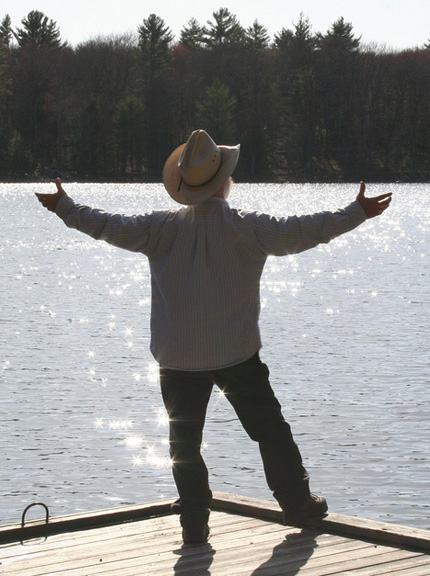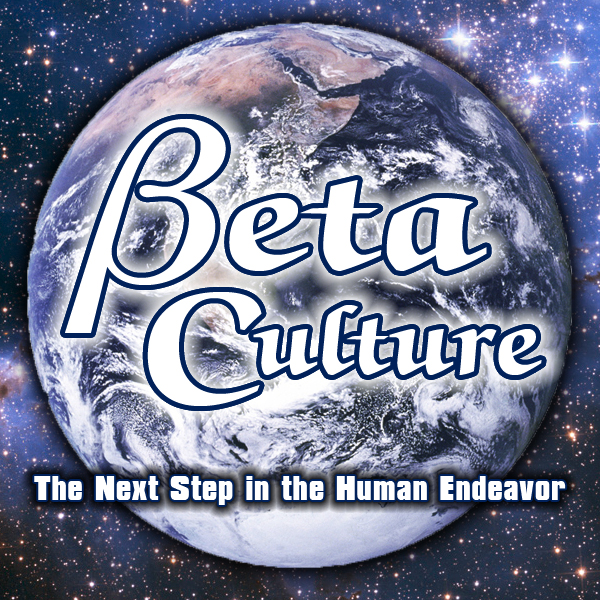 [ See Beta Culture Intro Part 1, Part 2, Part 3]
[ See Beta Culture Intro Part 1, Part 2, Part 3]
Futures Big and Small
Say there’s this future out there. And it’s … some way.
I mean, some real things are in it, and some real things are happening in it, and there are preceding real things – objects and events and people – that cause those things to be there, doing what they’ll do.
There are two futures we’re talking about. Or, really, one future viewed at two very different scales.
There’s the sort of private-life future that we ourselves plan and work and hope for. We go to college to brighten it, save money to cushion it, we eat right, exercise, all the stuff we know we have to do to get some sort of positive end result. Or we smoke, spend time on Facebook, blow the paycheck each week, but, again, get a future that, even if we hate it, is something we know we sort-of earned.
It’s that larger scale I really want to talk about, the larger public future shaped by greater forces than our small individual lives, and that takes place on a stage the size of the world. Unless you’re Abraham Lincoln or Bill Gates, affecting this future is pretty much out of your reach. As merely you-yourself and me-myself, we can neither change nor deny what’s coming. We can worry about it in vague terms, carp about it to friends, but mainly we just hang on for the ride.
The vital fact is that all our small private futures will take place in the shadow of the big public one. We will live our lives, every aspect of them, on that larger stage where the future of the world, or of humanity, plays out.
What we do in our own lives matters to that larger future only in a statistical way. We’re like individual molecules of air and moisture in the vast pattern of history’s weather. We blow to and fro, millions of us together, and wind happens, rain happens, tornadoes happen, ethnic migrations and wars and the rise and fall of empires happen.
But then again, there are larger forces at work in creating history’s weather. Humans can band together in certain ways to become large-scale social entities, and those social entities become massively more powerful on the stage of history. The things you and I do might vanish in the social noise, but these larger players will pretty much create the future.
Glorious vs. Ugly
Let me break for a moment to tell you some of what we might well be facing, futureward.
First, a couple of my Wise Old Sayings I Just Made Up:
Bad things happen automatically, but good stuff you have to work at.
Every new roommate will automatically assume someone else is in charge of housework.
Though phrased for the individual, both statements have statistical implications. Listen:
In an after-hours bar conversation with a climatologist several years back, I jokingly asked him “Tell me the truth; are we fucked?” There was a silent moment in which he stared at me in complete seriousness, before he quietly answered “Yeah. We’re fucked.” I’d already concluded something of the same thing, but it was still spooky to hear it.
We’re not fucked because anybody planned it or worked toward it, we’re fucked as a side effect of us living our lives, doing what we do, in all our billions.
Bad things happen automatically. Not just global warming, but Peak Oil, world economic shifts, resource depletion, oceans being fished out, fracking and groundwater contamination, growing numbers of endangered species, vanishing forests, mysteriously dying bees, human population continuing to increase (even if at a less-accelerated rate), increasing varieties of antibiotic-resistant bacteria, on and on.
And it’s all happening – right now in your own lifetime – not because somebody’s deliberately DOING it, but because nobody’s deliberately STOPPING it.
Like new roommates, we all assume someone else is dealing with it. We say “Hell, we’ve been hearing these gloom and doom predictions for all of history. Scientists will do something, discover something, invent something, to fix it. They always do.”
But for reasoning people, such simple optimism is misplaced. From a rational viewpoint, optimistically saying “scientists” or “the government” or “people of good will” will fix things is only a slight paraphrasing – and an exact conceptual match – to what godders say: “Hell, we couldn’t damage God’s creation. And even if we did, God could just fix it with a wave of his hand.”
It’s not just wishful thinking, it’s a blithe dismissal of the serious discussion that SHOULD take place. It shunts us away from the real understanding and real effort that might help fix things, if we only employed it.
So: Bad things are coming. And someone has to stop them, divert them, shift them onto some better path. Who?
The Big Three
Let’s get back to those “social entities.” Who are these larger players I spoke of? You could start to list them and never run out of list, but they fall into three main categories, it seems to me, and I list them as Government, Business and Religion.
Government is all of government, everything from the local city council, water board and school district to governments the size of nations. It’s building departments, prisons, highway paving crews, city and state parks, everything that government does or has jurisdiction over. Conceptually at least, government is there to provide services and protection, but in fact it also aims at considerable amounts of control and oversight of our private individual lives.
Business, these days, mean corporations – extra-national organizations aimed at profit.
Religion is the massed aggregate of churches, faiths, religious groups and even religious-activist individuals, ostensibly aimed at comfort and community, but really – from an atheist viewpoint – more aimed at coercion, control and profit, with reason-killing passions such as fear and hate as some of its prime tools.
All three of them also have this other main goal – continuity. Survival. Prosperity. Growth. Considering that there’s only so much to go around of what makes them up – money, power, allegiance, belief, cooperation – they work to leech more and more of the stuff out of the rest of us.
Government assumes greater power, creates new fields of regulation, runs our law enforcement and courts, starts wars, spies on private citizens and conceals information from us. Business (corporations) squeezes out more money or hours of our attention, sells us things, entertains and lies and manipulates us, seizes control of the food supply, runs our banks, keeps its secrets even when it’s in our interest to know what they know, penetrates our lives in ever deeper and broader ways. Religion pushes for greater social primacy, struggling for ways to subvert school boards, text books and classroom curricula, seeks influence over women’s intimate decisions, and works to control debates on social issues such as morality, freedom, and even science.
Think of the Big Three as vehicles into the future. They’re going there, each along their characteristic roadways, and we get to go along for the ride.
Or think of them as factories that crank out “future” in the same way auto-makers crank out cars and trucks.
So the Government Factory works to turn out a future tuned to Government needs, the Business Factory labors over a future based on Business needs and desires, and the Religion Factory turns out yet a third product aimed at Religion’s needs and mandates.
They produce futures reflecting their values and needs, and we end up living in them.
If you and I want a cure for Alzheimer’s, a city on the moon, or just a college degree for a son or daughter, we ride their vehicle, travel their road, look to their future-factory to produce the thing. Or we don’t get it.
I DO want a cure for Alzheimer’s. I DO want a city on the moon. I want a future-world where war is extinct, or just damned rare. I want radically-extended human lifespans (starting with mine!).
More modestly, I want a computer printer that can crank out a quarter of a million pages without breakdown, one that uses ink cartridges I can buy – for about two dollars per thousand pages – at any drug store or supermarket. Who’s going to create that for me? I mean, ever? Right, nobody.
The printer is technologically conceivable, therefore do-able. But I will never, ever, have one. Because the Big Three either have no interest in it, or a negative interest.
So we’ll face not only the looming disasters they ignore, but also the loss of all the good futures that might have been reached, but that they have no interest in. On the large public scale, we can have only those things that are accomplished – or unimpeded – by Government, Business, or Religion.
Also on this large public scale, there are some things I DON’T want, but will get anyway, because one or more of the Big Three have an interest, and because I can’t stop them. Unlabeled additives in my food, for instance, but also growing restrictions on women’s health resources and reproductive rights. Growing prison populations. Fascist-level police presences anytime you want to disagree in numbers with “your” government. Economic meddling. And never-ending efforts to shove religion into schools, textbooks, legislation, political rhetoric, every aspect of our lives.
The Lifeboat
As things stand, the future is in their hands. Almost every path into it will be controlled by these three entities. Which means … whatever future WE dream of, or hope for, or work toward, will be mediated – with controlling yes or no power – by THEM. We’ll all get to some sort of future, but we’ll get there in their boats, with them as captains charting the course.
I’m proposing something to put it at least partly back into ours: A fourth entity, a fourth road, into the future – a consciously created, crowd-sourced culture, a motivated aggregate of humans who not only direct their own future, but command the social room in which to do it.
This proposed fourth entity is the lifeboat from those others, our best hope for getting to some sort of future WE want to live in.
This is what I call Beta Culture.
I can’t see how it could hurt. I can see a lot of ways it could help.
And in fact, I think we desperately need it.
 [ Part 1 — 2 — 3— 4 — 5 — 6 – 7 — 8 ]
[ Part 1 — 2 — 3— 4 — 5 — 6 – 7 — 8 ]





